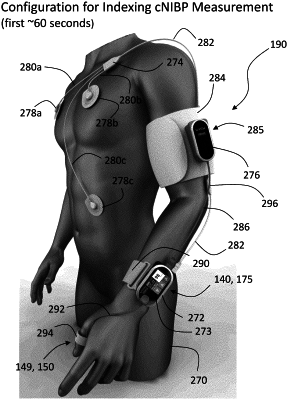| CPC A61B 5/0245 (2013.01) [A61B 5/02125 (2013.01); A61B 5/022 (2013.01); A61B 5/1118 (2013.01); A61B 5/14551 (2013.01); A61B 5/14552 (2013.01); A61B 5/349 (2021.01); A61B 5/681 (2013.01); A61B 5/6826 (2013.01); A61B 5/6838 (2013.01); A61B 5/746 (2013.01); A61B 5/021 (2013.01); A61B 5/02225 (2013.01); A61B 5/1116 (2013.01); A61B 5/6824 (2013.01); A61B 5/721 (2013.01); A61B 5/7239 (2013.01)] | 1 Claim |

|
1. A system for monitoring a patient, comprising:
an oximetry sensor comprising a photodetector and a first and second light source, the photodetector configured to generate a first signal by detecting a first radiation emitted by the first light source after the first radiation irradiates the patient, and a second signal by detecting a second radiation emitted by the second light source after the second radiation irradiates the patient, wherein the photodetector is configured to mate to a thumb of the patient at the base thereof such that the first and second signals are primarily measured from the princeps pollicis artery;
an ECG system comprising a housing configured to be positioned on the patient's chest, a differential amplifier circuit within the housing configured to operably connect to at least two electrodes and generate therefrom an ECG signal, and a first motion sensor within the housing to generate a first motion signal;
an oscillometric blood pressure monitoring system comprising a pump and a cuff, the oscillometric blood pressure monitoring system configured to be positioned on the patient's upper arm and generate an oscillometric blood pressure signal;
a second motion sensor configured to be positioned on the patient's arm above the elbow to generate a second motion signal;
a third motion sensor configured to be positioned on the patient's arm at the wrist to generate a third motion signal;
a processing unit configured to be worn on the patient's body and operably connected to the oximetry sensor to receive the first and second signals, to the ECG system to receive the ECG signal and the first motion signal, to the oscillometric blood pressure monitoring system to receive the oscillometric blood pressure signal, to the second motion sensor to receive the second motion signal, and to the third motion sensor to receive the third motion signal, the processing unit comprising a processor configured to process: i) the first and second signals to determine a value for oxygen saturation; ii) the second and third motion signals to determine a blood pressure calibration value compensating for hydrostatic forces due to arm height; iii) the first motion signal to determine the patient's torso orientation with respect to gravity; iv) the ECG signal, oscillometric blood pressure signal, and at least one of the first and second signals to determine a patient specific relationship between mean arterial blood pressure and pulse transit time; and v) the blood pressure calibration value, the patient's torso orientation, the patient specific relationship, the ECG signal, and at least one of the first and second signals to determine a blood pressure measurement for the patient.
|